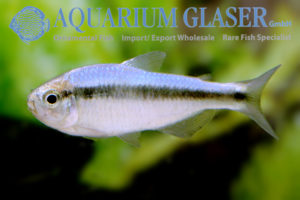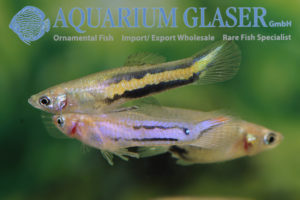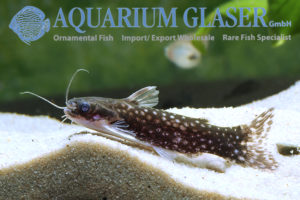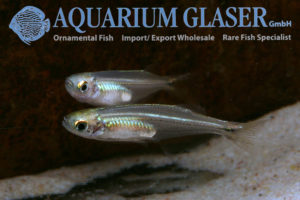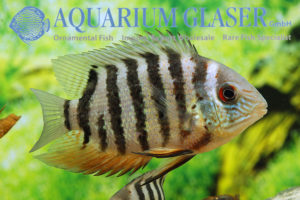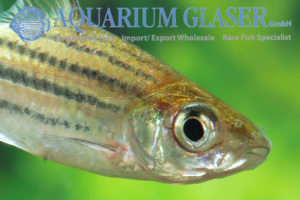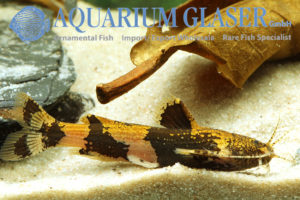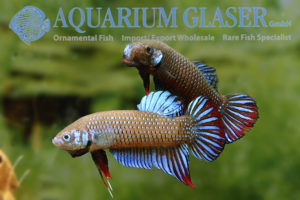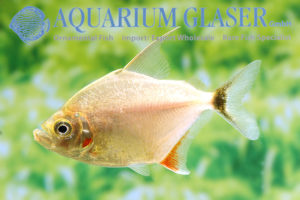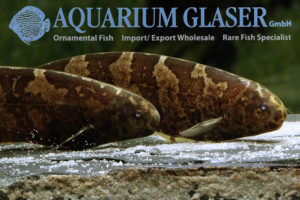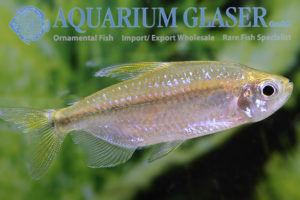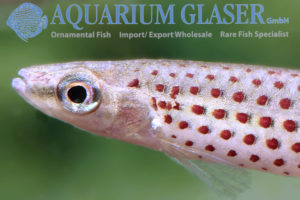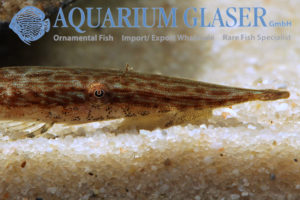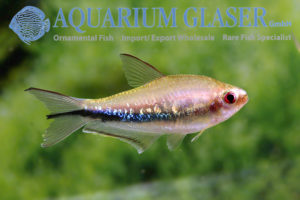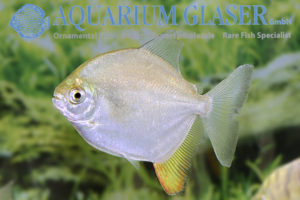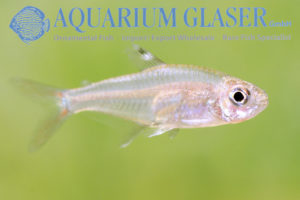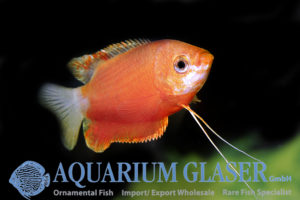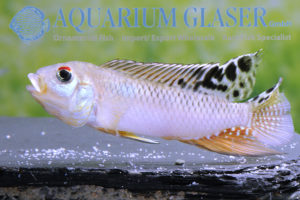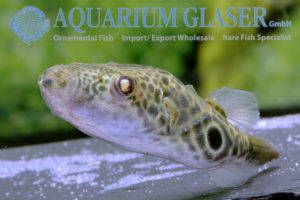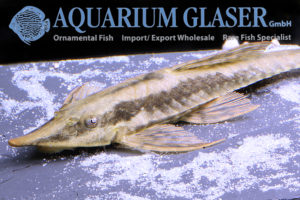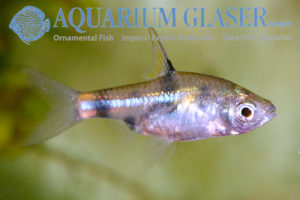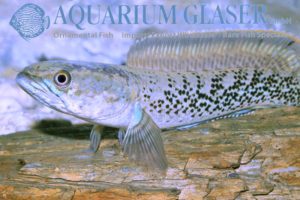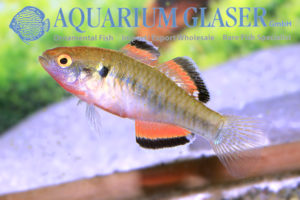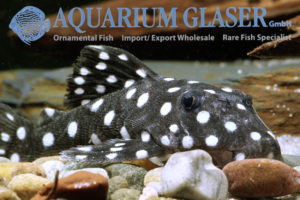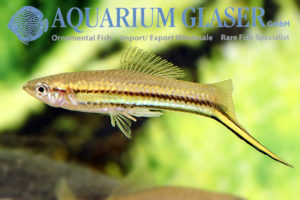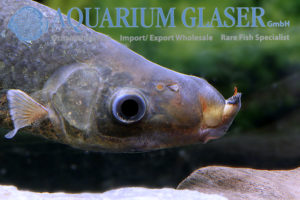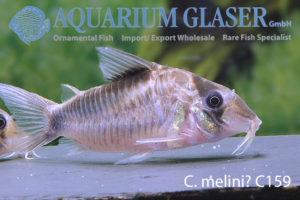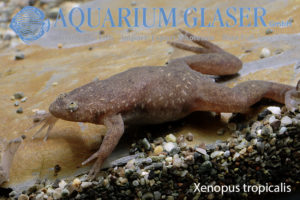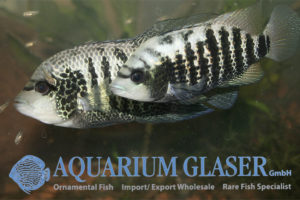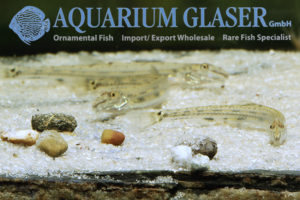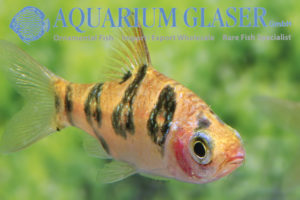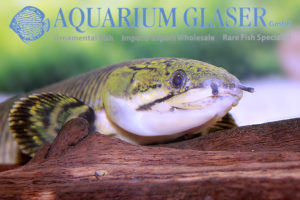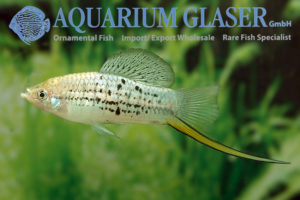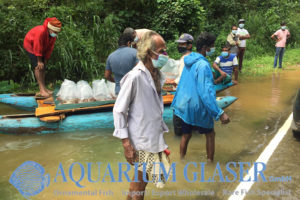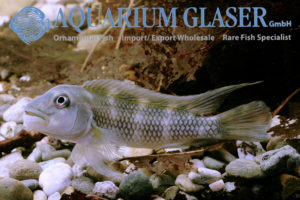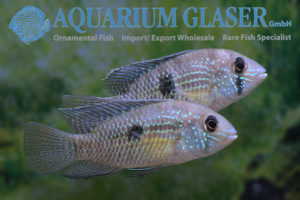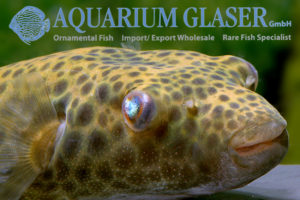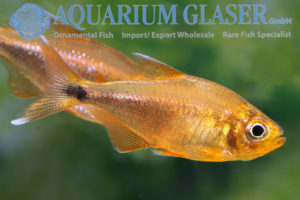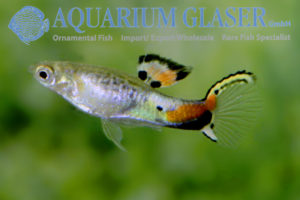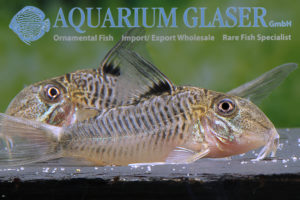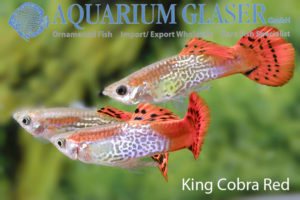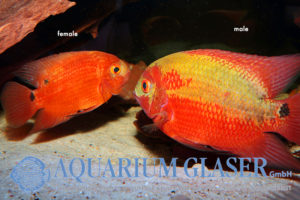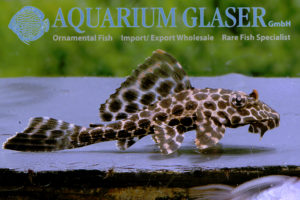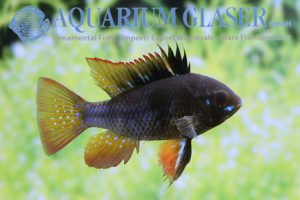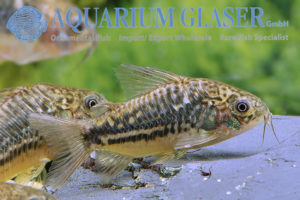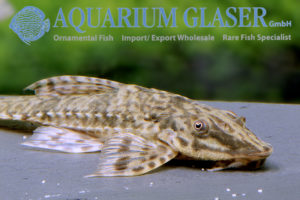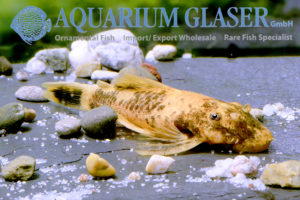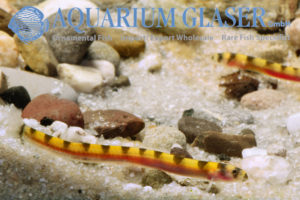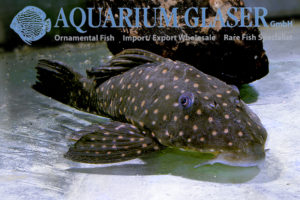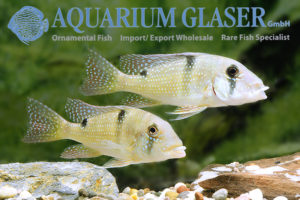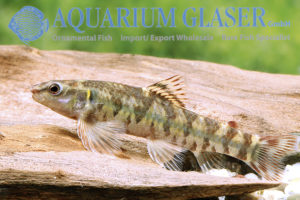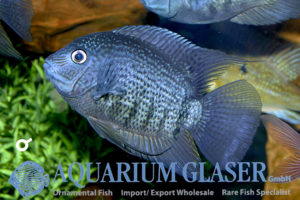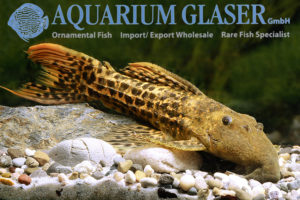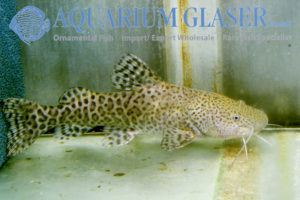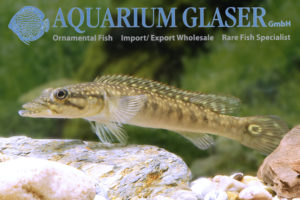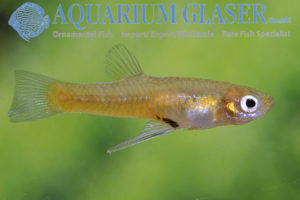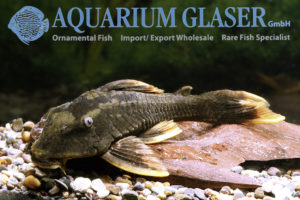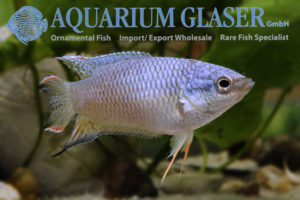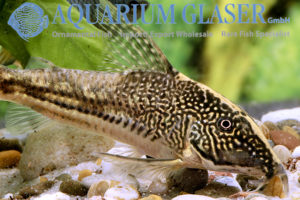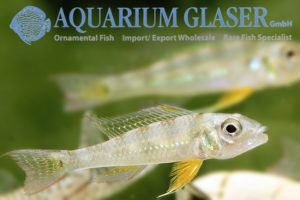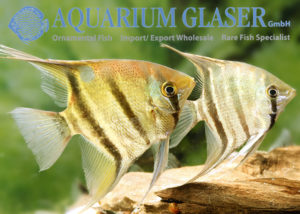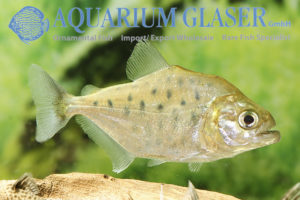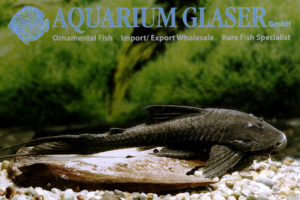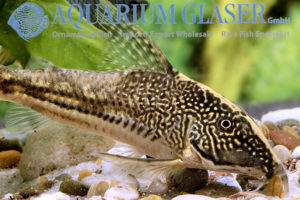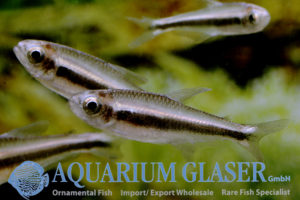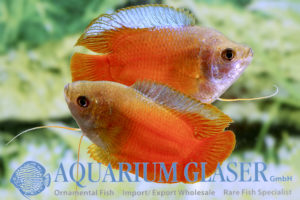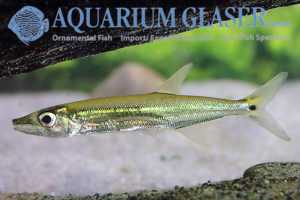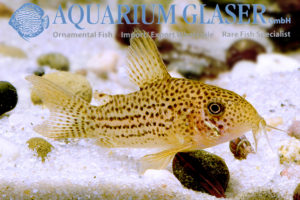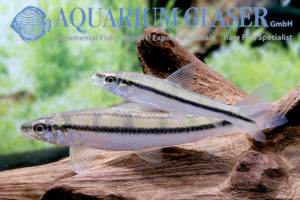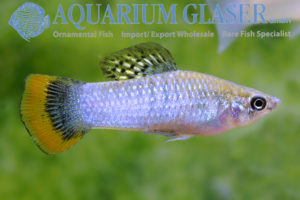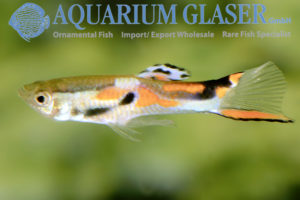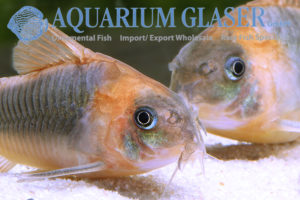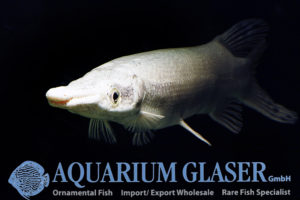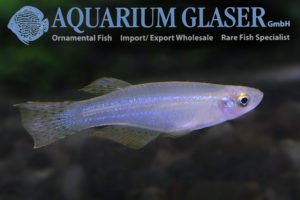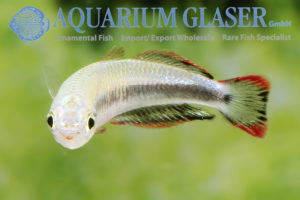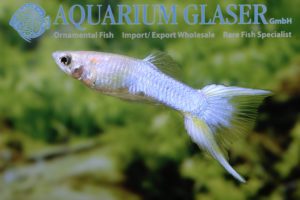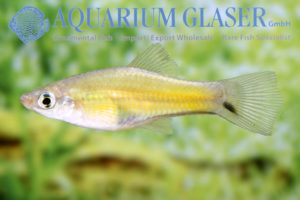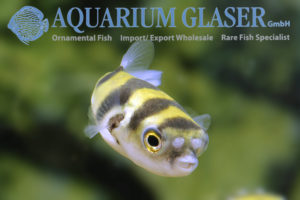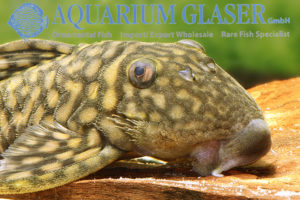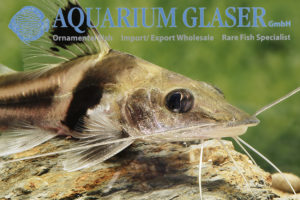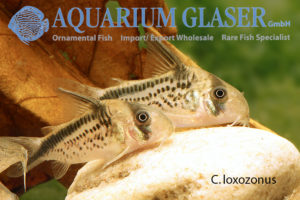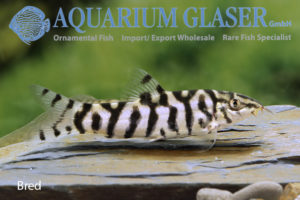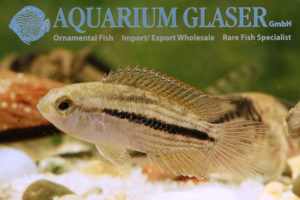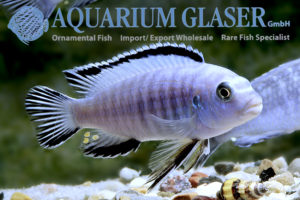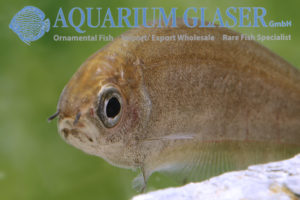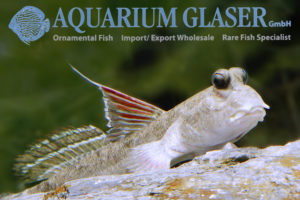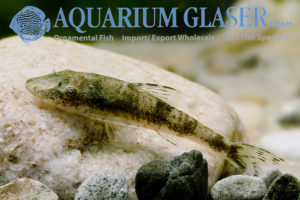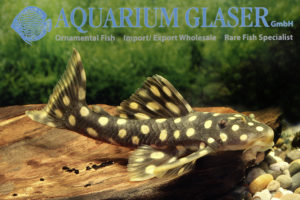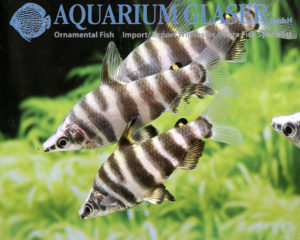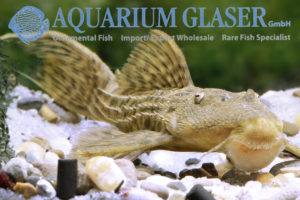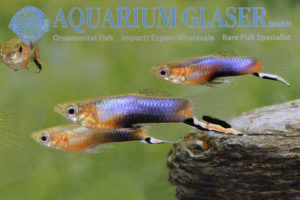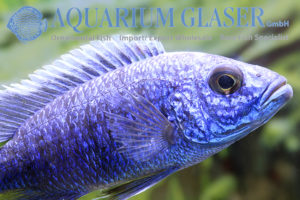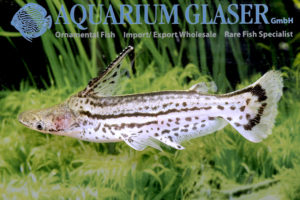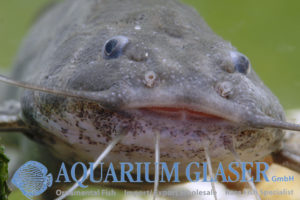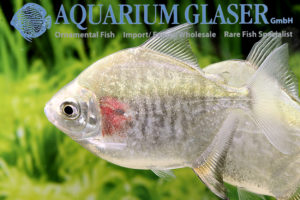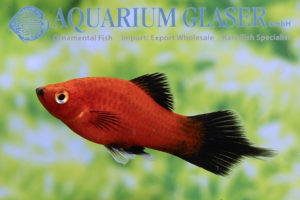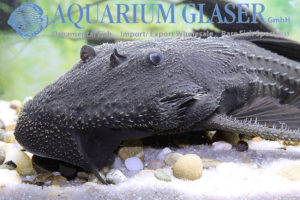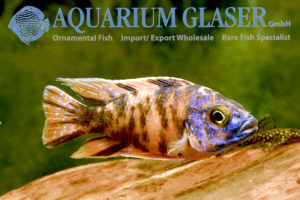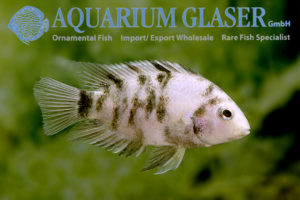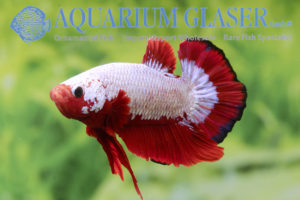At the moment we can offer magnificent, fully grown bred specimens of Hyphessobrycon melanostichos. Hyphessobrycon melanostichos is very eye-catching due to its bright sky-blue back coloration. The species was scientifically described in 2006 from the Brazilian state of Mato Grosso, where it occurs in the upper drainage of the Rio Tapajós. The species is distinguished […]
Fish Archive (3132)
-
-
Micropoecilia parae German Bred
Micropoecilia parae belongs to the very few fish species, whose breeding in the aquarium over numerous generations has not succeeded so far. Basically the reproduction of the viviparous fish is not difficult, but from generation to generation the animals become smaller and smaller, until finally no further breeding is possible, because the fish die before […]
-
Tatia galaxias
The cute Tatia catfishes are quite popular in the hobby. Keepers put up with the fact that you can hardly see them outside feeding times, because they are extremely addicted to hiding. But they make up for it with their pretty coloration and good breedability. Tatia galaxias comes from the Orinoco river basin in Colombia […]
-
Denticeps clupeoides
Herring can usually only be kept in the aquarium with enormous effort; moreover, most species live in the sea. Denticeps clupeoides is a small freshwater herring, it grows to a maximum length of 15 cm, but specimens over 8 cm in length are very rarely encountered. It lives in larger shoals near the surface in […]
-
Heros sp. Curare Bred
For the first time we could import this magnificent Heros from Venezuela in 2016. The animals should originate from a Rio Curare, therefore the name; however, no Rio Curare is known to us. We suspect the Rio Ventuari as origin. The fish are extremely colorful, otherwise everything speaks for the fact that it concerns the […]
-
Striuntius lineatus
Only in very few cases is such confusion around fish names as there is around the horizontically striped barbels of Southeast Asia. The beautiful animals belong according to current opinion to two genera: the species with clearly visible, long barbels belong to the genus Desmopuntius with currently seven accepted species and the form without (or […]
-
Akysis prashadi
The range of small, peaceful catfishes from Asia is much smaller than from South America, but they do exist. Moth catfishes (Hara, Erethistes) for low flow aquariums and wasp catfishes (Akysis) for tanks with more flow are becoming increasingly popular. Akysis get their name “wasp catfish” from the most famous species, Akysis vespa, whose sting […]
-
Betta imbellis
For many Betta imbellis is the prettiest wild fighting fish at all. Of course, “the” Betta imbellis does not exist at all, because the widespread species looks somewhat different everywhere. It is the sister species to Betta splendens and in fact no human being is able to distinguish completely decolorized specimens of both species from […]
-
Catoprion mento
Finally we managed to import Wimple Piranhas (Catoprion mento) once again. In nature C. mento is a scale eater – at least at certain times. In terms of feeding, right now is a good time of year because there are plenty of live white mosquito larvae now, which are an ideal food for Wimple Piranhas. […]
-
Steatogenys duidae
From Peru we have received exceptionally nice knifefishes of the species Steatogenys duidae. According to current knowledge the genus Steatogenys comprises three species, all of which have zebra-like stripes. With a final length of about 20 cm they remain comparatively small, only S. ocellatus grows significantly larger at 30 cm. The three species are very […]
-
Phenacogrammus cf. taeniatus
A new fashion trend in the hobby is emerging: tetras from the Congo! The region was already often in the focus of the hobby, but it was about killifishes or cichlids. The large flock of silver glittering open water species was of less interest. With the discovery of the unbelievably colorful Phenacogrammus sp. “Fantastique” (in […]
-
Copella meinkeni
These beautiful tetras were called Copella nattereri in literature for many years until a scientific study found that C. nattereri is in fact the species previously known as C. nigrofasciata and that the “C. nattereri” from the Orinoco and Rio Negro belong to a scientifically unnamed species called Copella meinkeni. We regularly offer this attractive […]
-
Acestridium dichromum
The strange sucking catfishes of the genus Acestridium – there are currently seven recognized species in the genus – could also be called “dwarf needle catfishes”, because they look like a miniature version of the needle catfishes of the genus Farlowella. Unfortunately, these animals are still an aquaristic challenge, which only very experienced aquarists should […]
-
Nematobrycon lacortei
The Rainbow Emperor Tetra (Nematobrycon lacortei) is certainly one of the most attractive tetras in South America. Its home is in western Colombia where it is caught in the catchment area of the Rio San Juan. Males and females can be easily distinguished by the color of the iris. Already in small juveniles the males […]
-
Myloplus torquatus
From Venezuela we received very nice Myloplus torquatus. The up to approx. 25 cm long species is scientifically known for a very long time (since 1858) and in the course of time it was already assigned to the genera Myletes and Myleus. A very good recognition feature is the black fringe in the caudal fin, […]
-
Hyphessobrycon dorsalis
Tetras, which – as Hans-Georg Evers so aptly put it – are magnificently white wine colored, have a hard time in aquarists. In the dealer’s tank there is usually nothing to be seen of the discreet colors and why, many ask, should one buy colorless fish when there are so many colorful species? This opinion […]
-
Colisa labiosa Ruby Red
Besides the orange colored breeding form of this gourami from Burma (see https://www.aquariumglaser.de/en/fish-archives/colisa-labiosa-orange-2/) there is also a very attractive, deep red colored breeding form. In order to keep these wonderful animals in their bright coloration permanently, it is necessary to provide certain types of food (e.g. Cyclops, Spirulina or also special flake food). Without the […]
-
Nanochromis cf. teugelsi
We have received beautiful offspring specimens of this magnificent Nanochromis from the Congo. Since the experts are not yet agreed whether this species is a color variant of Nanochromis teugelsi or a different species, we have chosen the name Nanochromis cf. teugelsi. The beautiful dwarf cichlids reach a length of about 7 cm in the […]
-
Pao sp. Chao Phraya
The cockade pufferfishes are a very complex group of freshwater pufferfishes. Formerly they were called the “Tetraodon-leiurus group”, but since 2013 they are in the genus Pao. The genus name Tetraodon is now only applied to the freshwater puffers of Africa. Throughout Southeast Asia (Thailand, Laos, Cambodia, Vietnam, Malaysia, Singapore, Indonesia), Pao freshwater puffers can […]
-
The sturgeon catfishes of Paraguay: Sturisoma barbatum or S. robustum?
From Paraguay wonderful, partly very large sturgeon catfishes (Sturisoma) are imported. Two Sturisoma species are known from the Rio Paraguay: S. barbatum, described already in 1853 by Kner, and S. robustum, described in 1904 by Regan. The two species differ from each other only insignificantly. The most important anatomical feature distinguishing the two species is […]
-
Pethia gelius
The golden barb (Pethia gelius) is an aquarium old-timer that found friends even before the First World War. It is one of the smallest barb species in India. Males rarely grow longer than 2.5 cm, females slightly larger. The record of 5 cm total length, which has been haunting the literature for decades, is probably […]
-
Channa stewartii
This snakehead, often traded under the name Channa cf. barca, originates from the northern Indian province of Assam. C. stewartii can reach a length of up to 30 cm (usually around 20 cm) and as a predatory fish should only be kept along with fish that are at least 2/3 of its body length. Besides […]
-
Hypseleotris compressa
Sometimes it happens that even we run short in finding superlatives: in any case this fish deserves to create one! It is so beautiful…. H. compressa is a sleeper goby that lives free swimming in the water column. In contrast to many other gobies this fish is not a bottom dweller. In Germany the genus […]
-
Baryancistrus sp. Snowflake LDA 33 / L142
This beautiful loricariid catfish comes from the Rio Tapajós in Brazil. Usually, 4-5 cm long youngsters are imported from these catfishes, which look very attractive with their large, white dots on a deep black ground and fully deserve the name “Snowball-Pleco”. In addition to high water temperatures (not below 28°C), these catfishes should be kept […]
-
Xiphophorus hellerii “Jalapa”
When you first see this slender, splendidly colored swordtail wild form, you involuntarily think: this is no X. hellerii! And yet, when X. hellerii was first described in 1848, exactly such animals became the type specimens. The traveler of the royal imperial horticultural society Karl Heller discovered and collected the animals in clear streams of […]
-
Sartor respectus
From the Rio Xingu we could import the probably strangest of all headstander: Sartor respectus. Unfortunately there were only two specimens, which one of our employees acquired. Nevertheless we did not want to withhold this speciality from you, dear readers. Sartor (there are two other very similar species, one from the Rio Trombetas (S. elongatus) […]
-
The “real” Corydoras melini?
One of the most important arguments for importing wild-caught fish for aquaristics is the gain in knowledge it allows. For the majority of small fish species this is only possible by observing living specimens. Without this there is no species knowledge, without species knowledge there is no species conservation. A wonderful example of the above […]
-
Xenopus tropicalis
Most likely, the trade of clawed frogs of the species Xenopus laevis will soon be banned because a reproducing population has been discovered in France. Due to climate change, it is now feared that this species could become invasive in Europe. To prevent this, the trade with this species should be prohibited. We would like […]
-
Mayaheros beani (formerly: Cichlasoma b.)
Origin: Rio San Christobal = Laguna El Camalote, San Blas, Nayarit, Mexico The small town of San Blas, where the Rio San Christobal empties into the Pacific Ocean, is considered the northernmost place with a tropical climate on the Pacific coast of Mexico. The name Laguna El Camalote was originally applied to a marshland southeast […]
-
Acanthopsoides robertsi
Horseface loaches (Acantopsis) are popular and well-known aquarium fishes, but with 15-20 cm attainable final length (the record is even 25 cm) they become quite large and therefore need larger aquariums. Practically unknown to aquarists are the dwarf horseface loaches (Acanthopsoides), whose seven species grow to only 3.5-5.5 cm in length. The photographed specimens are […]
-
Desmopuntius rhomboocellatus
Once again we have been able to import beautiful, fully grown specimens of the Orange Barb; unfortunately they are already sold out, but we want to use this opportunity to point out another of the numerous name changes of the Asian small barbs. Desmopuntius – the name means “convict barb” and refers to the striped […]
-
Polypterus mokelembembe
Bichirs are so called living fossils. Already 60 million years old fossils were found, which can still be assigned to living species today. However, there are only 16 known species, all coming from Africa. The last discovered and at the same time smallest species of the genus is Polypterus mokelembembe, which was described as a […]
-
Xiphophorus nezahualcoyotl
We have just obtained very attractive offspring of the “Northern Mountain Swordtail”. The fish are young adults, i.e. the sword of the males is still relatively short. For comparison we show here also an adult pair of another strain. In former times X. nezahualcoyotl was considered as a local variant of X. montezumae. The name […]
-
The global ornamental fish trade in times of Corona
The ornamental fish industry, as an international, global player, is naturally particularly affected by the pandemic; however, it is not only the virus and its direct effects that are causing problems for breeders, catchers and exporters around the world. Climatic changes, industrial conversion of the landscape, water pollution and social aspects also have a major […]
-
Steatocranus gibbiceps
Our current Congo import contains again two species of the funny humphead cichlids: Steatocranus casuarius and S. gibbiceps. They look very similar to each other at first sight (and we can hardly avoid in wholesale that sometimes a casuarius is among the gibbiceps and vize versa), but when looking closely you can see that in […]
-
Andinoacara latifrons Rio Atrato
This beautiful cichlid has been swimming in the world’s aquariums since 1906 and has been delighting for generations with its varied behavior and beautiful looking brood care. The animals are typical open breeders with parent family, i.e. both parents lead the numerous brood. Confusion gave in the course of time due naming. For a long […]
-
Pao abei (formerly: Tetraodon or Monotrete abei)
In Southeast Asia a group of freshwater puffers exists that is extremely difficult to tell apart on a specific level. They are called the Eyespot-Puffers or the Pao-leiurus-complex. These puffers live in streams and rivers, some also in ponds and lakes, always in pure freshwater. Among the most enigmatic species is Pao abei, which has […]
-
Hyphessobrycon moniliger
Under the name “Hasemania hansseni” a new tetra has recently appeared on the market, which with its intense orange coloration is indeed somewhat reminiscent of the well-known copper tetra, Hasamania nana. However, one of the characteristics of the genus Hasemania is that it lacks the adipose fin that is so typical for tetras. This is […]
-
Poecilia wingei Campoma No31 Snake Blue
Infinite is the variety of colors, patterns and color combinations possible in wild guppys. In natural biotopes no two males are alike. There are multiple mechanisms, genetic and biological, that ensure this. This is also true for the two wild guppy populations assigned to the species Poecilia wingei: Campoma and Cuminá. However, if individual males […]
-
Corydoras geoffroy
For a long time this fish, the type species of the genus Corydoras, was a mystery. Until today it is a top rarity among the armored catfishes. And so we are especially pleased to be able to offer offspring of this precious fish once again. The animals are still a bit inconspicuous, so we would […]
-
Filigran Guppys – King Cobra Guppys
The Filigran Guppys belong to the most popular Guppy forms. They have a body pattern of squiggles and dots, which is also called “Snakeskin” or King Cobra. This body pattern sometimes appears in wild Guppys, but it was not until the 1950s that it received more attention and was genetically characterized by M. Dzwillo in […]
-
Hypselecara temporalis OYAPOC
The Emerald cichlid has become a bit out of fashion. This is a quite sad thing, for this impressive large cichlid – males can become up to 30 cm long, females always stay much smaller – is one of the most beautiful species of cichlid of South America. Once more we can offer now German […]
-
Glyptoperichthys gibbiceps
The red highfin sucker is a classic, which found its lovers long before the invention of the L-numbers. Juveniles are really adorable and excellent algae killers. In addition they look very beautiful. Since this catfish easily grows to 30-40 cm in length, there are two camps among aquarists. Some are critical of the animal because […]
-
Mikrogeophagus ramirezi “Black”
Black butterfly cichlids have been around for a few years and many breeders do an excellent job on them, so that really beautiful and healthy animals come on the market. We have now received a strain of Black Rams, in which the blue of the scales is limited to the rear half of the body […]
-
Corydoras undulatus Paraguay
The beautiful Corydoras undulatus belongs to the relationship of C. elegans. Like most representatives of this group the species swims rather in free water than on the ground. Also typical for the group is that males and females differ clearly in color. In the case of C. undulatus the males become very dark with bright […]
-
Rineloricaria parva
From Paraguay we regularly receive shipments of the small whiptail catfishes of the genus Rineloricaria. No less than 65 species are currently recognized, which makes identification in many cases almost impossible without knowledge of their origin. But in the case of Paraguay, there is a recent revision of the species known from this river system […]
-
Ancistrus Orange Brown “LDA16”
This extremely attractive Ancistrus is a breeding form. The actual LDA 16 is a wild form imported in 1994 from Brazil (Rio Puraqequara, a tributary of the Rio Guamá, which in turn is a tributary of the Rio Tocantins) and is uniformly purple-brown in color. We do not know if the orange-blotched Ancistrus descended from […]
-
Pangio cuneovirgata
Usually the different species of banded Coolie loaches (Pangio kuhlii, P. semicincta, P. myersi, P. shelfordi, P. alternans, P. cuneovirgata, P. malayana) are not distinguished in the trade because they are so variable in color and are often imported mixed. The sorting of Coolie loach is an activity you don’t want your worst enemy to […]
-
Hypostomus roseopunctatus L311
Not less than 148 species are counted to the genus Hypostomus, but no five of them appear more often in the trade. Special is of course H. luteus with its sail-like dorsal fin and the bright yellow coloration, but most species are “plecos”, brown or gray with black spots. In addition, most species grow quite […]
-
Geophagus harreri
In very small numbers we have received this beautiful Geophagus as German offspring. The species reaches a maximum length of 20-25 cm and is exclusively found in the inlet of the Marowijne River, the border river between French Guyana and Suriname. One of the tributaries of the Marowijne is the Maroni River, known to cichlid […]
-
Characidium fasciatum (C. cf. pterostictum, P. sp. V)
The South American darters of the genus Characidium are unfortunately almost indeterminable. There is no current revision of the 95 described species, but additional species are constantly being described and it is known that there are still numerous scientifically unrecorded species. In aquaristics one therefore helps oneself by simply calling everything “Characidium fasciatum”, well knowing […]
-
Heros sp. Madeira
The Rio Madeira is a right tributary of the Amazon River and is considered the largest tributary in the world. Its origin is in Bolivia where it is formed from the confluence of the Rio Beni and the Rio Marmoré. It flows into the Amazon in Brazil at Itacoatiara. The Rio Madeira is a white […]
-
Pseudacanthicus sp. L273 Titanic
The magnificent cactus catfish L273 Titanic, up to 30 cm long, originates from the Rio Tapajós. Its first import in 1998 was a sensation. Interesting about the animals, which are allowed to be exported from Brazil again since some time, is the very individual body pattern. All cactus catfishes are carnivores; towards non-species fishes they […]
-
Zungaro zungaro
The catfish Zungaro zungaro belongs to the largest catfish species of South America. There were all kinds of debates about its name, for a long time it sailed under Pseudopimelodus zungaro or Paulicea luetkeni. Because of its gigantic size (length up to 140 cm, weight up to 50 kg) the species is difficult to study […]
-
Crenicichla jegui
The pike cichlids (Crenicichla) are with 94 accepted species (and there are still a large number of undescribed ones) the most species-rich genus of cichlids at all. One of the most distinctly different species is Crenicichla jegui from the Rio Tocantins drainage. There the fish lives very hidden and was therefore discovered only when the […]
-
Girardinus uninotatus
From the currently seven accepted species of the genus Giradinus only G. metallicus and occasionally G. falcatus are offered in the trade. We have now received a small number of G. uninotatus from a breeder. They are really no color miracle, but their pretty apricot color is quite interesting. The species oirginates from Cuba. The […]
-
Cochliodon sp. L360
We have received some beautifully marked yellowseam catfish. This catfish originates from the middle Rio Jamanxin in Brazil and has not yet been correctly (i.e. scientifically) identified, neither in terms of genus nor in terms of species. However, it is quite possible that this catfish has already been scientifically described; young animals are quite inconspicuous, […]
-
Macropodus spechti “Royal Blue”
For the first time we can offer this magnificent breeding form of the black paradise fish. Our breeder writes about it: How did I become aware of these fish: In 2019, I saw a picture of blue paradise fish from Vietnam in a Facebook group for paradise fish lovers by chance. Being skeptical at first […]
-
Scleromystax barbatus
The changed legal situation in Brazil now makes the import of several species from the south of Brazil possible again, which for many years were only available as offspring, among them the magnificent Scleromystax barbatus (formerly Corydoras b.). We have been able to import a good number of wonderful, fully grown specimens. For more information […]
-
Biotoecus dicentrarchus
The dwarf cichlids of the genus Biotoecus were shrouded in mystery for decades. The first species, B. opercularis, was scientifically described as early as 1875. It originated from the Amazon River basin in Brazil, a well-collected area for aquaristic purposes, and yet the first import was not accomplished until the mid-1980s and early 1990s. The […]
-
Pterophyllum leopoldi (“dumerilii”)
This season we received especially attractive Pterophyllum leopoldi from Brazil. Unfortunately, the animals do not like the photo tank at all and show there only a fraction of the wonderful colors – a magnificent green shimmer all over the body and a very nice red tone in the back – that well acclimated animals of […]
-
Serrasalmus cf. gouldingi
It is indicative of the difficulties in piranha identification that this widespread species, which also occurs in an area intensively collected for the aquarium hobby (namely, the Rio Negro) was not scientifically described until 1992 and, moreover, almost never appears in the hobby. The terra typica is Anavilhanas, Río Negro, Brazil. The representatives of this […]
-
L350 Panaque sp. Black Lyretail
From Peru we received four specimens of a top rarity: L350. This peculiar fish does not fit any genus of loricariid catfish known to date. It originates from deep, turbid, very fast flowing water of the Peruvian Amazon, where it can only be caught with great difficulty and rarely. It is a carnivorous species whose […]
-
Scleromystax barbatus
The changed legal situation in Brazil now makes the import of several species from the south of Brazil possible again, which for many years were only available as offspring, among them the magnificent Scleromystax barbatus (formerly Corydoras b.). We have been able to import a good number of wonderful, fully grown specimens. For more information […]
-
Moenkhausia phaeonota
This small (about 4 cm) species of tetra originates from upper Rio Tapajós basin the Mato Grosso state in Brazil. It is the only species of Moenkhausia with such a colour pattern. So already in the original scientific description (1979) the author mentioned that this generic placement can be only provisionally. This makeshift stands until […]
-
Colisa lalia “Flame Red
Only from few breeding forms is so well known, when they originated, as with Colisa lalia “Flame Red”. At the same time the fish decorated the covers of all aquaristic journals worldwide in the early 1980s, so sensational were they found. The animals were bred in the Lim Choa Kang area of Singapore, a rural […]
-
Acestrorhynchus cf. minimus
Unfortunately, almost all predatory fishes have one unpleasant characteristic: most of them grow too large for average aquarium dimensions. In many cases we can only keep juveniles for some time and have to part with them when it becomes nice. What a pity! An exception to this rule is Acestrorhynchus minimus, a barracuda tetra from […]
-
Corydoras eversi (C65)
The very nice Corydoras eversi lives in the Araguaia drainage (Brazil) and became known as C 65. It was only scientifically described in 2016. The scientific treatment of C. eversi is based on a collection by Hans-Georg Evers in 1998, who was also able to bring living animals with him. As mentioned, they were initially […]
-
Apareiodon affinis
Now begins the season for one of the best algae eaters of all, the La Plata algae eater from Paraguay. Originally the species was described as Parodon affinis. It is amazingly similar in shape and coloration to the Asian Flying Foxes; but of course, the La Plata algae eater can always be easily recognized by […]
-
Poecilia mexicana “Campeche”
The wild mollies are – from a zoological-systematic point of view – certainly one of the most difficult fish groups at all. Not without reason, science has been wavering between two extreme views for over 100 years: the first states that all wild mollies belong to only one, highly variable species, which would then be […]
-
Guppy Endler
No fish species is as changeable as the Guppy. There are no two males in nature that are exactly alike in color. This is true for all four Guppy species (Poecilia reticilata, P. wingei, P. obscura and P. kempkesi), which therefore cannot really be distinguished from each other externally (genetically, however, they can). In the […]
-
Coryoras eques
From the Brazilian state of Amazonas, more precisely from the surroundings of the city of Anori, we once again received a good number of a beautiful armored catfish, which is known to science for a long time, but rarely appears aquaristically: Corydoras eques. This typical schooling Corydoras looks most attractive when kept in black water. […]
-
Atractosteus spatula
The Alligator gars are so-called living fossils. They developed about 100 million years ago in the upper Cretaceous and haven´t changed much since then. Currently two genera live in the New World, namely Atractosteus (containing three species) and Lepisosteus (four species). The members of Atractosteus can reach about 2 m in length (formerly they are […]
-
Procatopus aberrans
Again we could import the lampeye fish Procatopus aberrans from NIgeria; unfortunately we do not know the location where they were collected. However, we know that our supplier occasionally receives fish from Cameroon. Anyway, the current imports are a bit more graceful in body structure and the upper half of the iris lacks the red […]
-
Bedotia geayi
This is the only almost always available aquarium fish that comes from the large, geologically old island of Madagascar. All other freshwater fishes from this island, which unfortunately are often threatened with extinction due to massive environmental changes, are only suitable for specialists. The beautiful Madagascar rainbow (Bedotia geayi) grows to a length of 10-12 […]
-
Guppy Japan Blue and Japan Red
There is a number of tail fin shapes of the guppy, which have been standardized by the guppy breeders. As a rule, however, these breeds are only found at private breeders. In the pet trade the triangle guppies dominate in such a way that aquarists, who do not inform themselves specifically about guppies, could get […]
-
Xiphophorus signum
This species of swordtail is only very rarely offered in the trade. At the first glimpse one may think that they are a variety of the common swortail X. hellerii, but the species X. signum is much more slender. The mark that is responsible for the scientific name (latin signum = sign) is always good […]
-
Colomesus asellus
The South American puffer fish Colomesus asellus are ideal for aquarium care. They remain small (usually around 6-8 cm, at most around 12 cm, other sizes given in the literature are based on confusion), are pure freshwater inhabitants, love to eat small snails and are absolutely peaceful, both against conspecifics and against other fish species. […]
-
Spectracanthicus (= Oligancistrus) zuanoni L 354
Spectracanthicus zuanoni L 354 originates from Rio Xingu and the Rio Iriri in Brazil. It has been described scientifically only in 2014 (see http://www.aquariumglaser.de/en/archiv.php?news_id=1195). The fish belongs to the same species as L 20, with however clearly larger white marks, so that the design reminds of a black net on a bright background. The reddish, […]
-
Pimelodus ornatus
One of the most attractive large catfishes is Pimelodus ornatus, which is common in large parts of tropical South America. It is reported from the big rivers Amazonas, Orinoco and Parnaná, in addition the Guyana states. Maximum size reported is 38.5 cm (excluding caudal fin). The beautiful and lively fish is notorious for its venomous […]
-
Corydoras loxozonus and C. sp. aff. C16
Corydoras loxozonus belongs to the beautiful armored catfishes, which we receive relatively regularly from Colombia. The species is quite variable in pattern and therefore has already received the C-numbers C79 and C83. There was never any “proof” that these C-numbers really belong to the species C. loxozonus; this was only concluded from the fact that […]
-
Botia lohachata
The systematics of the Indian deep bodied loaches – they represent the remaining species in the formerly much broader genus Botia – is confused. Botia lohachata was described from Bihar in India as early as 1912. Their coloration is very specific: three Y-shaped bands – the first in front, the second below and the third […]
-
Nannacara taenia
Nannacara taenia is with a maximum of 5 cm total length one of the smallest cichlids at all. Additionally it is absolutely peaceful and therefore an ideal fish for community aquariums. The species was described in 1911 from aquarium fishes believed to have been exported via Manaus. However, these animals were never found again in […]
-
Chindongo socolofi (= Pseudotropheus s.)
What is the saying? Who does not ask, remains stupid. In the case of the rock cichlids of Lake Malawi, the so-called Mbuna, it is undoubtedly the garish, bright colors that initially attract attention and led to the much quoted comparison with coral fish. In fact, the colors of the mbuna have primarily the same […]
-
Xenomystus nigri
Knifefishes are found in the Old World (Africa, Asia) and in the New World (South and Central America). However, the two groups are not closely related. Aquaristically, however, they are quite comparable. They inspire above all by their elegant swimming. The very special fin structure allows them to maneuver both forward and backward. At the […]
-
Periophthalmus novemradiatus
The Indian Dwarf Mudskipper, Periophthalmus novemradiatus, is the ideal aquarium mudskipper with its usually 6 cm length (in literature up to 10 cm are given, but we have never seen such large specimens, probably this statement is based on confusion with other species). In addition to its small size, it has many other favorable attributes: […]
-
Curculionichthys sabaji
A very long name for a very small fish! The genus Curculionichthys was established only in 2015 to accommodate dwarf sucker catfishes of the subfamily Hypoptopomatinae (formerly: Otothyrinae) of Loricariidae, which were previously placed in the genus Hisonotus. Both anatomical and molecular data showed that two independent evolutionary lineages existed within Hisonotus, namely that around […]
-
Ancistrini sp. L82
Among the species threatened by the construction of the Bela Monte Dam is L82, a species of loricariid up to about 15 cm long, which cannot yet be assigned to any genus described scientifically to date; it is most similar to Scobinancistrus. Also on species level L82 is not yet worked on. The only certainty […]
-
Abramites hypselonotus
The marbled headstander is perhaps the most unusual of all headstanders. This beautiful fish grows to about 15-20 cm in length and is hard to mistake because of its high body shape. There is only a second Abramites species, A. eques, but it has never been imported alive. It lives exclusively in the Rio Magdalena […]
-
Pseudacanthicus sp. L79
This very flat Pseudacanthicus from the Rio Tocantins belongs to the rarest L-catfishes on the market. Even before the export ban by the Brazilian authority IBAMA, which was lifted only recently, the fish came to us only very sporadically. L79 certainly grows over 20 cm long, but exactly how big is unknown. Our animals are […]
-
Poecilia wingei Blue Star
Poecilia wingei is widely distributed in the hobby after its best known local variant as Endler´s Guppy. It remains much smaller than the normal Guppy and is very popular with many aquarists because of its graceful body shape. Just as with the common Guppy, numerous local forms can be observed with P. wingei. The ancestor […]
-
Sciaenochromis fryeri
Many rock dwelling cichlids (mbunas) of Lake Malawi live isolated on certain rocky shores. These are often miles away from other rocky biotopes, so geographic isolation leads relatively quickly to local color variations. Other cichlids of the lake, such as Sciaenchromis fryeri, are not bound to specific biotopes and occur accordingly throughout the lake. Although […]
-
Ageneiosus magoi
Males of all dolphin catfishes (Ageneiosus) develop huge dorsal fin spines and a penis-like mating organ at spawning time, also strange tooth-like looking papillae on the posterior margin of the upper jaw. They use the dorsal fin spine to clamp females for mating, and fertilization occurs internally. After spawning, the dorsal fin spine is shed […]
-
Wertheimeria maculata
Wertheimeria maculata belongs to the strangest thorny catfishes. You don’t see this on the relatively inconspicuous juveniles with their 6-8 cm length, but it is nevertheless so. The first thing that catches your attention is the really high price that is demanded for them. This is due to the fact that these fish are local […]
-
Mylesinus paucisquamatus
A few weeks ago we introduced you to a new pacu, which we received as Tometes kranponhah. At that time we thought the animals originated from the Rio Xingu. (see https://www.aquariumglaser.de/en/fish-archives/tometes-kranponhah-2/) In the meantime, further correspondence with our supplier revealed that the animals did indeed come from the Rio Tocantins. We have received another shipment […]
-
Platy Wagtail Pointed Tail
The “pointed tail” mutation, in which the middle caudal fin rays are elongated, appeared relatively late: the first specimens appeared on the market in the 1980s. It originated in the Southeast Asian large-scale breederies. The characteristic, which first appeared in the Platy (Xiphophorus maculatus), can also be transferred to other Xiphos, but the pointed tail […]
-
Acanthicus sp. L155 Furo Maguari
Acanthicus hystrix is one of the great myths in the literal sense. With a length of almost one meter it is one of the largest loricariid catfishes at all. In addition, the species, which was already described in 1829, is extremely prickly: “hystrix” means “porcupine”! Unfortunately, the specimen on which the description of this species […]
-
Aulonocara Orange Blotched
Everything there is to say about these wonderfully colorful cichlids has already been said about another breeding variety, the Aulonocara Dragon Blood: https://www.aquariumglaser.de/en/fish-archives/aulonocara-dragon-blood-2/ The Orange Blotched are now one of the most common Malawi cichlids on the market. No wonder: there is hardly a fish species, which shows such a variety of bright colors, like […]
-
Amatitlania (formerly Cichlasoma) nigrofasciata Marble
The convict cichlid Amatitlania (formerly Cichlasoma) nigrofasciata is really not a novelty anymore: it has been kept and bred in aquariums since 1939. The first aquarium animals of this very widely distributed fish in Central America came from the lakes Atitlan and Amatitlan in Guatemala. The genus to which the convict cichlid currently belongs was […]
-
Betta splendens Hellboy II
Some time ago we introduced a short-finned fighting fish breeding form (“Pla Kat”) of Betta splendens as “Hellboy”. (https://www.aquariumglaser.de/en/fish-archives/betta-splendens-pla-kat-hellboy-and-giant-halfmoon/). Now we have received Pla Kat under this name from Thailand again, but they differ from the first Hellboys in color and fins. The new Hellboys have a halfmoon tail fin, which means that when the […]
- « Previous Page
- 1
- …
- 7
- 8
- 9
- 10
- 11
- …
- 32
- Next Page »





